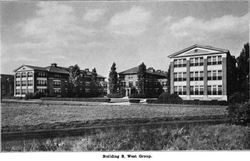Boston State Hospital
| Boston State Hospital | |
|---|---|
 | |
| Established | 1839 |
| Opened | 1884 (Second Location) |
| Closed | 1987 |
| Current Status | Demolished |
| Building Style | Cottage Plan |
| Location | Boston, MA |
| Peak Patient Population | 3,100 in 1951 |
| Alternate Names |
|
History[edit]
The Boston State Hospital – originally called the Boston Lunatic Asylum – was founded in South Boston in 1839. By the 1880s, new ideas about the care of the mentally ill emphasized the importance of fresh air, hard work, and separation from the adverse influences (both social and environmental) of city life, an approach that was referred to as “moral treatment.” Thus, when the time came to move out of the old and overcrowded facilities in South Boston, the Asylum’s leaders looked to West Roxbury – at that time a semi-rural area that had only recently been incorporated into the city of Boston – as an appropriate setting for a new hospital.
Beginning in 1884, some Asylum residents were moved to the former almshouse at Austin Farm, just across Morton Street from the present Boston Nature Center, where the Harvard Commons development stands today. In 1892, looking for more room for both buildings and farmland, the City purchased the 35-acre Pierce Farm, along Walk Hill and Canterbury Streets – part of which land is now the western end of the BNC. A few years later, the City bought another parcel of land, adjoining Pierce Farm and Canterbury Street, which now includes much of the Clark Cooper Community Gardens and other areas in the central part of the BNC.
It was soon decided that Austin Farm would house women, while Pierce Farm became the “Department for Men” of the recently renamed Boston Insane Hospital. The new buildings at Pierce Farm, designed by city architect Edmund March Wheelwright, opened in 1895, and a few additional farm buildings were added over the following years.
In 1908, the city sold the buildings and 153 acres of land to the state for one million dollars, and the facility was renamed the Boston State Hospital. Hospital trustees envisioned a grand expansion scheme, published in the 1919 Annual Report, to fully develop the hospital to a maximum capacity of 5000 patients. This scheme was never fully realized, due primarily to the State Board of Insanity's position that no facility for the mentally ill should house more than 2000 patients. Construction of the Metropolitan state Hospital in Haltham in 1930 "led to a much reduced and seemingly haphazard building program" at Boston State.
Expansion at the hospital temporarily halted in 1920, and resumed with the construction of a number of buildings under public work projects in the 1930s. Most recent construction took place in the late 1960s/early 1970s. The oldest building on hospital property a ca. 1865 farmhouse near Walk Hill Street, burned and was subsequently razed in the winter of 1989.
In 1951 the resident population of the hospital hit an all-time high of 3,100, about 30% over the institution’s official capacity. The facility had extensive farming and, similar to Medfield State Hospital, emphasized fresh air, hard work, and separation from the adverse influences of city life to help restore the patients’ mental health by incorporating residents in the operations, expansions, and improvements as an important part of therapy.
Almost all of the buildings from the former BSH have been demolished except for three cottages that have been restored and are now being used by the Mass Audubon Nature Center, and another old building that will be renovated by the U. Mass Biologic Laboratory. There still remains a significant amount of unused, overgrown land and wetlands, although the old roads still exist and can be used. Other than the properties that have been sold, DCAMM is the land owner. In 1996, with the unanimous approval of the Community Advisory Committee for the Boston State Hospital planning process, the Massachusetts Audubon Society bought the Boston State Hospital land from the City at a price of $10 per acre. Mass Audubon then established a community adversary board of 30 people, more than half of whom came from surrounding communities (The Boston Nature Center and Wildlife Sanctuary, 1996).
Images of Boston State Hospital[edit]
Main Image Gallery: Boston State Hospital






